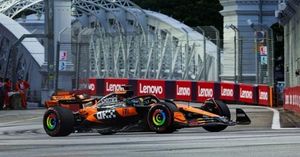North Korea is once again in the international spotlight, this time for its twin roles in advancing domestic naval power and deepening its military partnership with Russia. On October 6, 2025, North Korean state media released a series of striking photographs: Supreme Leader Kim Jong Un, flanked by senior officials, touring the country’s first-ever destroyer, the Choe Hyon. The visit, which took place during North Korea’s third annual Defense Development 2025 exhibition, was more than a simple photo op—it was a clear message to the world about Pyongyang’s ambitions and evolving military capabilities.
According to the Korean Central News Agency (KCNA), Kim praised the destroyer as “a great proof of the validity and vitality of the WPK’s line of self-defense.” The 465-foot, 5,000-ton warship represents a significant leap for the Korean People’s Navy, which, until recently, relied on aging vessels and fast attack boats. State media offered the public its first look inside the Choe Hyon, showing Kim inspecting everything from the crew quarters and bridge to the ship’s high-tech combat command center, replete with multifunction consoles.
But it’s not just the optics that have changed. Naval News reported that the Choe Hyon has undergone several notable modifications since its initial unveiling in April 2025. The ship’s vertical launch systems (VLS), previously fitted with 32 small-diameter missile cells at the front, have been reconfigured. Now, both the forward and aft launchers are identical, each featuring larger cells—a total of 24. In addition, at least eight 14.5 mm KPVT heavy machine guns have been added to the vessel, signaling a focus on both offensive and defensive capabilities.
“The fact that all weapons and related sensor systems of the destroyer were tested off Nampo on April 28–29 makes their replacement only a few months later even more curious from an operational standpoint,” Naval News observed. The outlet speculated on whether the VLS was designed for modular replacement or if the earlier setup was simply a prototype, quickly swapped out for something more advanced. Either way, these rapid upgrades suggest a sense of urgency—and perhaps experimentation—within North Korea’s naval program.
The Choe Hyon’s commissioning was followed by a less triumphant moment: the botched launch of North Korea’s second destroyer in May 2025, which resulted in significant damage to the vessel. According to state media, Kim Jong Un responded by ordering the arrest of several officials involved in the incident, underscoring the regime’s zero-tolerance approach to failure when it comes to military modernization.
Kim himself has been unambiguous about the strategic importance of these new warships. During the launch ceremony for the second destroyer, he declared, “Possessing operations capability on the oceans and exercising naval power there is our indispensable option for defending our national sovereignty and security interests. It is not long before the enemy forces themselves will experience how offending and unpleasant it is to have to watch their rival’s warships cruising on the fringes of their territorial waters.” The message was unmistakable: North Korea intends to project power well beyond its shores, and its adversaries—namely the United States, South Korea, and Japan—should take note.
Yet, even as Pyongyang touts its latest naval advances, its military ambitions extend far beyond the Korean Peninsula. According to Ukraine’s Foreign Intelligence Service, North Korea has become one of the main suppliers of weapons to the Russian army, now covering up to half of its ammunition needs. Intelligence officer Oleh Aleksandrov told Ukrinform that “currently, North Korea provides between 35% and 50% of Russia’s ammunition supply, shipping about 200,000 to 260,000 shells of 152 mm and 122 mm calibres each month.”
But the support doesn’t stop at ammunition. North Korea has also delivered multiple rocket launchers and short-range ballistic missiles—including the KN-23 and KN-24 systems—which Russia has reportedly used to strike Ukrainian cities. This military pipeline has transformed the war in Ukraine into a testing ground for North Korean weaponry, with both Moscow and Pyongyang eager to refine their arms under real-world conditions.
The partnership between North Korea and Russia has grown so close that, as of October 2025, Ukrainian intelligence estimates between 8,500 and 13,000 North Korean soldiers are stationed in Russia’s Kursk Region. Their presence allows Moscow to redeploy its own troops to the front lines in Ukraine. In September 2025 alone, another 1,000 North Korean military personnel—including engineers, sappers, and construction specialists—arrived in the Kursk region, further cementing the alliance.
It’s not just soldiers crossing the border. The Kremlin is also importing North Korean labor migrants to compensate for workforce shortages fueled by Russia’s ongoing mobilization. More than 17,800 North Koreans are currently employed in Russia, with another 26,000 expected to be hired soon. About 6,000 of these workers are slated for construction projects in territories temporarily occupied by Russian forces in Ukraine, according to Ukrainian intelligence.
This deepening military and economic relationship has alarmed Western officials and analysts. The United States and its allies have long accused North Korea of flouting United Nations sanctions in pursuit of hard currency and strategic leverage. Now, with Pyongyang openly supplying Russia’s war effort and modernizing its own military at home, those concerns are only intensifying.
For North Korea, the benefits are clear. The regime gains much-needed revenue, access to Russian military technology, and a powerful partner on the world stage. For Russia, North Korean support helps offset the impact of international sanctions and sustain its campaign in Ukraine. The arrangement is mutually beneficial—and deeply troubling for those hoping to contain either country’s military ambitions.
Back in Pyongyang, the focus remains on the future. According to state media, both Choe Hyon-class destroyers are slated to enter service by mid-2026. If all goes according to plan, North Korea will soon possess a pair of warships capable of operating far from its own shores, challenging regional security dynamics and further complicating the already tense standoff on the Korean Peninsula.
As North Korea’s navy takes bold steps forward and its alliance with Russia grows ever tighter, the world watches with a mix of anxiety and fascination. The coming months will reveal whether these moves are a genuine leap in capability or simply another round of saber-rattling from one of the world’s most isolated regimes.




